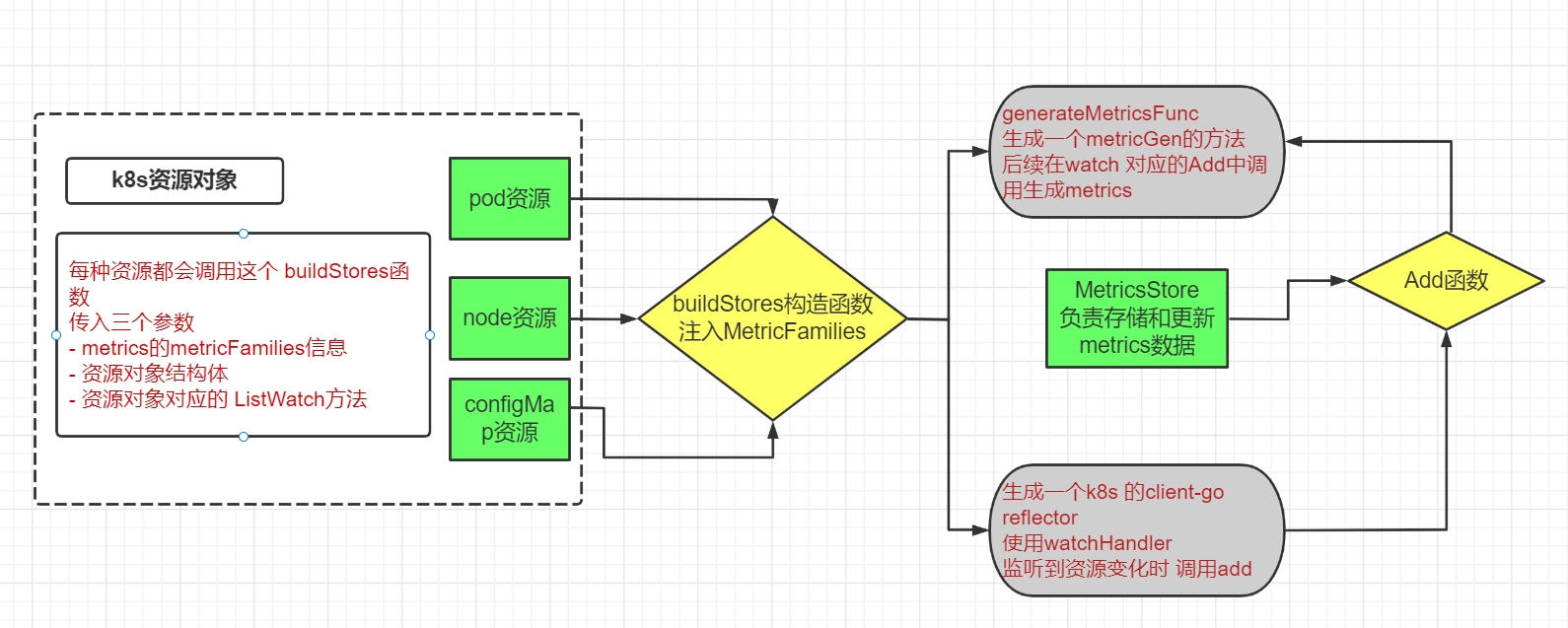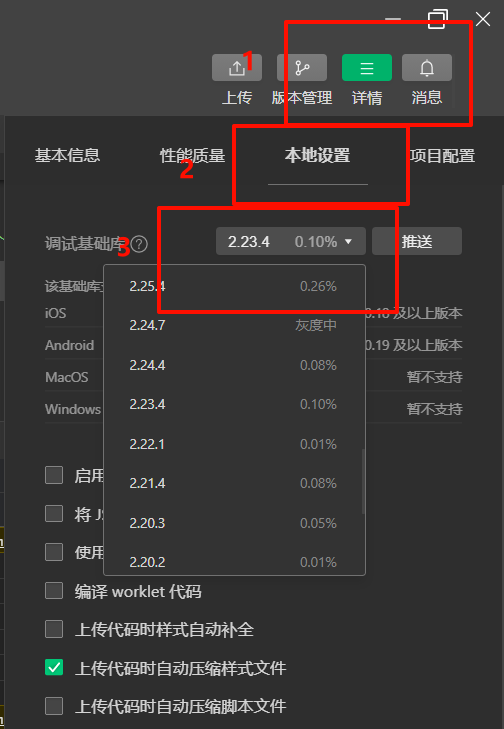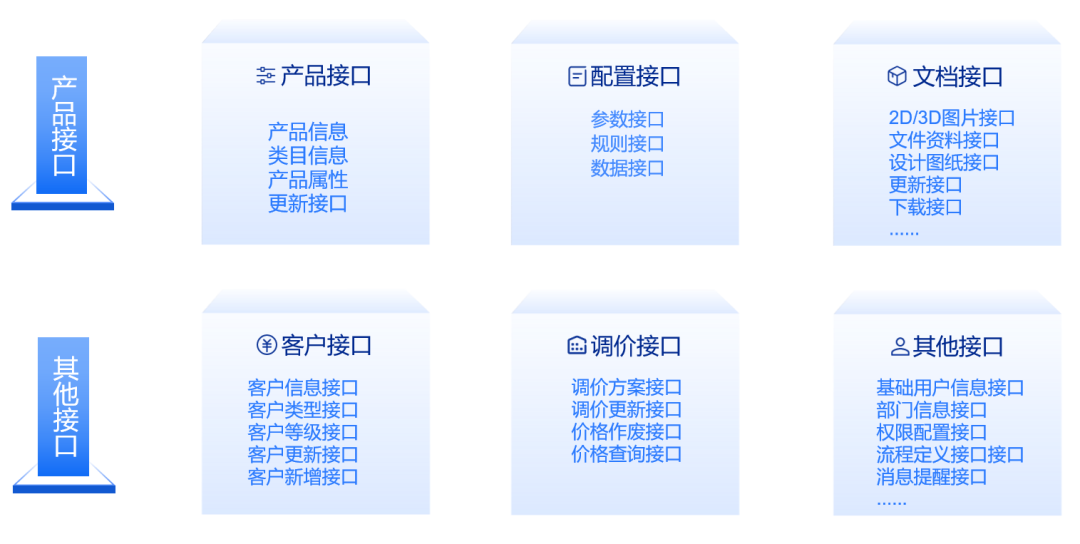本节重点介绍 :
- k8s资源对象的 buildStores构造函数注入MetricFamilies
- k8s client-go 之 Reflector
- listAndWatch 方法
- watchHandler 监听更新,调用add等action
架构图总结

项目地址
- 地址
go get
go get -v -d k8s.io/kube-state-metrics/v2@v2.1.1
源码分析
main.go 中的主流程
- 位置 D:\go_path\pkg\mod\k8s.io\kube-state-metrics\v2@v2.1.1\main.go
初始化store.Builder
storeBuilder := store.NewBuilder()
注册registery
ksmMetricsRegistry := prometheus.NewRegistry()
ksmMetricsRegistry.MustRegister(version.NewCollector("kube_state_metrics"))
durationVec := promauto.With(ksmMetricsRegistry).NewHistogramVec(
prometheus.HistogramOpts{
Name: "http_request_duration_seconds",
Help: "A histogram of requests for kube-state-metrics metrics handler.",
Buckets: prometheus.DefBuckets,
ConstLabels: prometheus.Labels{"handler": "metrics"},
}, []string{"method"},
)
storeBuilder.WithMetrics(ksmMetricsRegistry)
解析命令行中启用的resource
var resources []string
if len(opts.Resources) == 0 {
klog.Info("Using default resources")
resources = options.DefaultResources.AsSlice()
} else {
klog.Infof("Using resources %s", opts.Resources.String())
resources = opts.Resources.AsSlice()
}
- 如果没有指定就用默认的 ,位置 D:\go_path\pkg\mod\k8s.io\kube-state-metrics\v2@v2.1.1\pkg\options\resource.go
// DefaultResources represents the default set of resources in kube-state-metrics.
DefaultResources = ResourceSet{
"certificatesigningrequests": struct{}{},
"configmaps": struct{}{},
"cronjobs": struct{}{},
"daemonsets": struct{}{},
"deployments": struct{}{},
"endpoints": struct{}{},
"horizontalpodautoscalers": struct{}{},
"ingresses": struct{}{},
"jobs": struct{}{},
"leases": struct{}{},
"limitranges": struct{}{},
"mutatingwebhookconfigurations": struct{}{},
"namespaces": struct{}{},
"networkpolicies": struct{}{},
"nodes": struct{}{},
"persistentvolumes": struct{}{},
"persistentvolumeclaims": struct{}{},
"poddisruptionbudgets": struct{}{},
"pods": struct{}{},
"replicasets": struct{}{},
"replicationcontrollers": struct{}{},
"resourcequotas": struct{}{},
"secrets": struct{}{},
"services": struct{}{},
"statefulsets": struct{}{},
"storageclasses": struct{}{},
"validatingwebhookconfigurations": struct{}{},
"volumeattachments": struct{}{},
}
解析命令行中的启用的namespace
if len(opts.Namespaces) == 0 {
klog.Info("Using all namespace")
storeBuilder.WithNamespaces(options.DefaultNamespaces)
} else {
if opts.Namespaces.IsAllNamespaces() {
klog.Info("Using all namespace")
} else {
klog.Infof("Using %s namespaces", opts.Namespaces)
}
storeBuilder.WithNamespaces(opts.Namespaces)
}
- 如果没传入,则采集所有namespace的资源对象
根据命令行传入的 metrics 黑白名单进行设置
allowDenyList, err := allowdenylist.New(opts.MetricAllowlist, opts.MetricDenylist)
if err != nil {
klog.Fatal(err)
}
err = allowDenyList.Parse()
if err != nil {
klog.Fatalf("error initializing the allowdeny list : %v", err)
}
klog.Infof("metric allow-denylisting: %v", allowDenyList.Status())
storeBuilder.WithAllowDenyList(allowDenyList)
最为关键的一步
- 具体干什么先不讲,先跳过
storeBuilder.WithGenerateStoresFunc(storeBuilder.DefaultGenerateStoresFunc())
创建kubeClient
kubeClient, vpaClient, err := createKubeClient(opts.Apiserver, opts.Kubeconfig)
if err != nil {
klog.Fatalf("Failed to create client: %v", err)
}
storeBuilder.WithKubeClient(kubeClient)
根据apiserver地址+kubeconfig配置文件创建 或者 使用 restclient.InClusterConfig创建client
- 位置 D:\go_path\pkg\mod\k8s.io\client-go@v0.21.2\tools\clientcmd\client_config.go
func BuildConfigFromFlags(masterUrl, kubeconfigPath string) (*restclient.Config, error) {
if kubeconfigPath == "" && masterUrl == "" {
klog.Warning("Neither --kubeconfig nor --master was specified. Using the inClusterConfig. This might not work.")
kubeconfig, err := restclient.InClusterConfig()
if err == nil {
return kubeconfig, nil
}
klog.Warning("error creating inClusterConfig, falling back to default config: ", err)
}
return NewNonInteractiveDeferredLoadingClientConfig(
&ClientConfigLoadingRules{ExplicitPath: kubeconfigPath},
&ConfigOverrides{ClusterInfo: clientcmdapi.Cluster{Server: masterUrl}}).ClientConfig()
}
- 默认不传apiserver地址信息,采用inclusterconfig方式创建,启动日志如下
W0820 04:31:20.664175 1 client_config.go:543] Neither --kubeconfig nor --master was specified. Using the inClusterConfig. This might not work.
- inclusterconfig方式验证 sa和token
oklogrun 启动metrichandler
var g run.Group
m := metricshandler.New(
opts,
kubeClient,
storeBuilder,
opts.EnableGZIPEncoding,
)
// Run MetricsHandler
{
ctxMetricsHandler, cancel := context.WithCancel(ctx)
g.Add(func() error {
return m.Run(ctxMetricsHandler)
}, func(error) {
cancel()
})
}
metricshandler run
- 位置 D:\go_path\pkg\mod\k8s.io\kube-state-metrics\v2@v2.1.1\pkg\metricshandler\metrics_handler.go
func (m *MetricsHandler) Run(ctx context.Context) error {
autoSharding := len(m.opts.Pod) > 0 && len(m.opts.Namespace) > 0
if !autoSharding {
klog.Info("Autosharding disabled")
m.ConfigureSharding(ctx, m.opts.Shard, m.opts.TotalShards)
<-ctx.Done()
return ctx.Err()
}
- 默认不开启分片,执行m.ConfigureSharding
func (m *MetricsHandler) ConfigureSharding(ctx context.Context, shard int32, totalShards int) {
m.mtx.Lock()
defer m.mtx.Unlock()
if m.cancel != nil {
m.cancel()
}
if totalShards != 1 {
klog.Infof("configuring sharding of this instance to be shard index %d (zero-indexed) out of %d total shards", shard, totalShards)
}
ctx, m.cancel = context.WithCancel(ctx)
m.storeBuilder.WithSharding(shard, totalShards)
m.storeBuilder.WithContext(ctx)
m.metricsWriters = m.storeBuilder.Build()
m.curShard = shard
m.curTotalShards = totalShards
}
- 这里会根据 storeBuilder执行Build方法
请求metric时对应的serveHttp方法
- 位置 D:\go_path\pkg\mod\k8s.io\kube-state-metrics\v2@v2.1.1\pkg\metricshandler\metrics_handler.go
func (m *MetricsHandler) ServeHTTP(w http.ResponseWriter, r *http.Request) {
m.mtx.RLock()
defer m.mtx.RUnlock()
resHeader := w.Header()
var writer io.Writer = w
resHeader.Set("Content-Type", `text/plain; version=`+"0.0.4")
if m.enableGZIPEncoding {
// Gzip response if requested. Taken from
// github.com/prometheus/client_golang/prometheus/promhttp.decorateWriter.
reqHeader := r.Header.Get("Accept-Encoding")
parts := strings.Split(reqHeader, ",")
for _, part := range parts {
part = strings.TrimSpace(part)
if part == "gzip" || strings.HasPrefix(part, "gzip;") {
writer = gzip.NewWriter(writer)
resHeader.Set("Content-Encoding", "gzip")
}
}
}
for _, w := range m.metricsWriters {
w.WriteAll(writer)
}
// In case we gzipped the response, we have to close the writer.
if closer, ok := writer.(io.Closer); ok {
closer.Close()
}
}
- 其中最关键的是,遍历 m.metricsWriters 调用WriteAll
for _, w := range m.metricsWriters {
w.WriteAll(writer)
}
metricsWriters是何方神圣
- 是在ConfigureSharding中执行的m.storeBuilder.Build()
m.metricsWriters = m.storeBuilder.Build()
m.storeBuilder.Build()
- 位置 D:\go_path\pkg\mod\k8s.io\kube-state-metrics\v2@v2.1.1\internal\store\builder.go
// Build initializes and registers all enabled stores.
// It returns metrics writers which can be used to write out
// metrics from the stores.
func (b *Builder) Build() []metricsstore.MetricsWriter {
if b.allowDenyList == nil {
panic("allowDenyList should not be nil")
}
var metricsWriters []metricsstore.MetricsWriter
var activeStoreNames []string
for _, c := range b.enabledResources {
constructor, ok := availableStores[c]
if ok {
stores := constructor(b)
activeStoreNames = append(activeStoreNames, c)
if len(stores) == 1 {
metricsWriters = append(metricsWriters, stores[0])
} else {
metricsWriters = append(metricsWriters, metricsstore.NewMultiStoreMetricsWriter(stores))
}
}
}
klog.Infof("Active resources: %s", strings.Join(activeStoreNames, ","))
return metricsWriters
}
- 其中的核心就是遍历 availableStores,执行他们的 buildXXXXStore函数
- 比如 configmap对应的就是
"configmaps": func(b *Builder) []*metricsstore.MetricsStore { return b.buildConfigMapStores() },
- 对应就是
func (b *Builder) buildConfigMapStores() []*metricsstore.MetricsStore {
return b.buildStoresFunc(configMapMetricFamilies, &v1.ConfigMap{}, createConfigMapListWatch)
}
- 看到这里发现每个资源对象都会调用 b.buildStoresFunc 注入MetricFamilies
b.buildStoresFunc
- 这个buildStoresFunc 对应的就是main中
storeBuilder.WithGenerateStoresFunc(storeBuilder.DefaultGenerateStoresFunc())
- 底层是 buildStores这个函数
func (b *Builder) buildStores(
metricFamilies []generator.FamilyGenerator,
expectedType interface{},
listWatchFunc func(kubeClient clientset.Interface, ns string) cache.ListerWatcher,
) []*metricsstore.MetricsStore {
metricFamilies = generator.FilterMetricFamilies(b.allowDenyList, metricFamilies)
composedMetricGenFuncs := generator.ComposeMetricGenFuncs(metricFamilies)
familyHeaders := generator.ExtractMetricFamilyHeaders(metricFamilies)
if isAllNamespaces(b.namespaces) {
store := metricsstore.NewMetricsStore(
familyHeaders,
composedMetricGenFuncs,
)
listWatcher := listWatchFunc(b.kubeClient, v1.NamespaceAll)
b.startReflector(expectedType, store, listWatcher)
return []*metricsstore.MetricsStore{store}
}
stores := make([]*metricsstore.MetricsStore, 0, len(b.namespaces))
for _, ns := range b.namespaces {
store := metricsstore.NewMetricsStore(
familyHeaders,
composedMetricGenFuncs,
)
listWatcher := listWatchFunc(b.kubeClient, ns)
b.startReflector(expectedType, store, listWatcher)
stores = append(stores, store)
}
return stores
}
每种资源都会调用这个 buildStores函数
func (b *Builder) buildConfigMapStores() []*metricsstore.MetricsStore {
return b.buildStoresFunc(configMapMetricFamilies, &v1.ConfigMap{}, createConfigMapListWatch)
}
传入三个参数
- metrics的metricFamilies信息
- 资源对象结构体
- 资源对象对应的 ListWatch方法
composedMetricGenFuncs metrics gen方法
- 生成一个metricGen的方法
- 然后构造一个MetricsStore
store := metricsstore.NewMetricsStore(
familyHeaders,
composedMetricGenFuncs,
)
- 构造一个listWatcher,一并传入 startReflector
listWatcher := listWatchFunc(b.kubeClient, v1.NamespaceAll)
b.startReflector(expectedType, store, listWatcher)
reflector用来watch特定的k8s API资源
func (b *Builder) startReflector(
expectedType interface{},
store cache.Store,
listWatcher cache.ListerWatcher,
) {
instrumentedListWatch := watch.NewInstrumentedListerWatcher(listWatcher, b.listWatchMetrics, reflect.TypeOf(expectedType).String())
reflector := cache.NewReflector(sharding.NewShardedListWatch(b.shard, b.totalShards, instrumentedListWatch), expectedType, store, 0)
go reflector.Run(b.ctx.Done())
}
metrics 更新
- D:\go_path\pkg\mod\k8s.io\kube-state-metrics\v2@v2.1.1\pkg\metrics_store\metrics_store.go
func (s *MetricsStore) Add(obj interface{}) error {
o, err := meta.Accessor(obj)
if err != nil {
return err
}
s.mutex.Lock()
defer s.mutex.Unlock()
families := s.generateMetricsFunc(obj)
familyStrings := make([][]byte, len(families))
for i, f := range families {
familyStrings[i] = f.ByteSlice()
}
s.metrics[o.GetUID()] = familyStrings
return nil
}
- 当有对象更新时,会调用generateMetricsFunc生成对应的指标,塞入map中
k8s 的client-go reflector.watchHandler 监听到资源变化时 调用add
- 源码位置 D:\go_path\pkg\mod\k8s.io\client-go@v0.21.2\tools\cache\reflector.go
// watchHandler watches w and keeps *resourceVersion up to date.
func (r *Reflector) watchHandler(start time.Time, w watch.Interface, resourceVersion *string, errc chan error, stopCh <-chan struct{}) error {
eventCount := 0
// Stopping the watcher should be idempotent and if we return from this function there's no way
// we're coming back in with the same watch interface.
defer w.Stop()
loop:
for {
select {
case <-stopCh:
return errorStopRequested
case err := <-errc:
return err
case event, ok := <-w.ResultChan():
if !ok {
break loop
}
if event.Type == watch.Error {
return apierrors.FromObject(event.Object)
}
if r.expectedType != nil {
if e, a := r.expectedType, reflect.TypeOf(event.Object); e != a {
utilruntime.HandleError(fmt.Errorf("%s: expected type %v, but watch event object had type %v", r.name, e, a))
continue
}
}
if r.expectedGVK != nil {
if e, a := *r.expectedGVK, event.Object.GetObjectKind().GroupVersionKind(); e != a {
utilruntime.HandleError(fmt.Errorf("%s: expected gvk %v, but watch event object had gvk %v", r.name, e, a))
continue
}
}
meta, err := meta.Accessor(event.Object)
if err != nil {
utilruntime.HandleError(fmt.Errorf("%s: unable to understand watch event %#v", r.name, event))
continue
}
newResourceVersion := meta.GetResourceVersion()
switch event.Type {
case watch.Added:
err := r.store.Add(event.Object)
if err != nil {
utilruntime.HandleError(fmt.Errorf("%s: unable to add watch event object (%#v) to store: %v", r.name, event.Object, err))
}
case watch.Modified:
err := r.store.Update(event.Object)
if err != nil {
utilruntime.HandleError(fmt.Errorf("%s: unable to update watch event object (%#v) to store: %v", r.name, event.Object, err))
}
case watch.Deleted:
// TODO: Will any consumers need access to the "last known
// state", which is passed in event.Object? If so, may need
// to change this.
err := r.store.Delete(event.Object)
if err != nil {
utilruntime.HandleError(fmt.Errorf("%s: unable to delete watch event object (%#v) from store: %v", r.name, event.Object, err))
}
case watch.Bookmark:
// A `Bookmark` means watch has synced here, just update the resourceVersion
default:
utilruntime.HandleError(fmt.Errorf("%s: unable to understand watch event %#v", r.name, event))
}
*resourceVersion = newResourceVersion
r.setLastSyncResourceVersion(newResourceVersion)
if rvu, ok := r.store.(ResourceVersionUpdater); ok {
rvu.UpdateResourceVersion(newResourceVersion)
}
eventCount++
}
}
watchDuration := r.clock.Since(start)
if watchDuration < 1*time.Second && eventCount == 0 {
return fmt.Errorf("very short watch: %s: Unexpected watch close - watch lasted less than a second and no items received", r.name)
}
klog.V(4).Infof("%s: Watch close - %v total %v items received", r.name, r.expectedTypeName, eventCount)
return nil
}
架构图总结

本节重点介绍 :
- k8s资源对象的 buildStores构造函数注入MetricFamilies
- k8s client-go 之 Reflector
- listAndWatch 方法
- watchHandler 监听更新,调用add等action


















![[C#]winform 使用opencvsharp实现玉米粒计数](https://i-blog.csdnimg.cn/direct/8afef5f08c764fba967ee4595a67841c.jpeg)